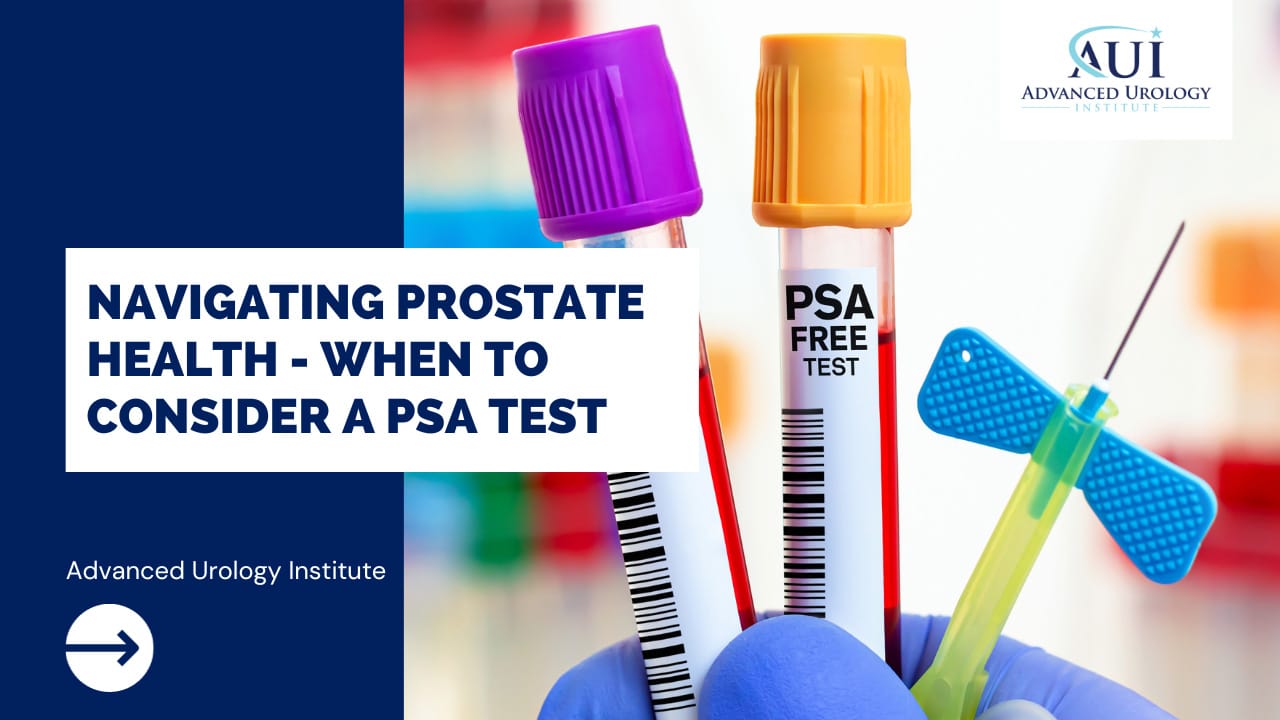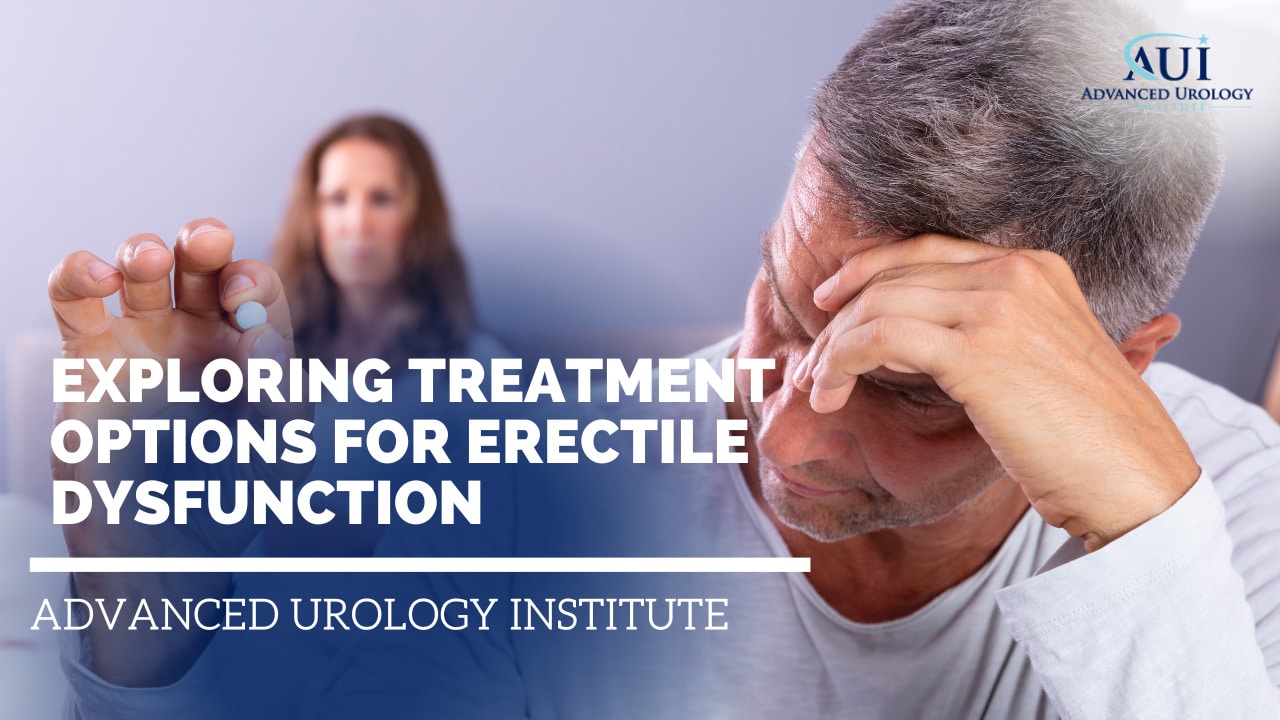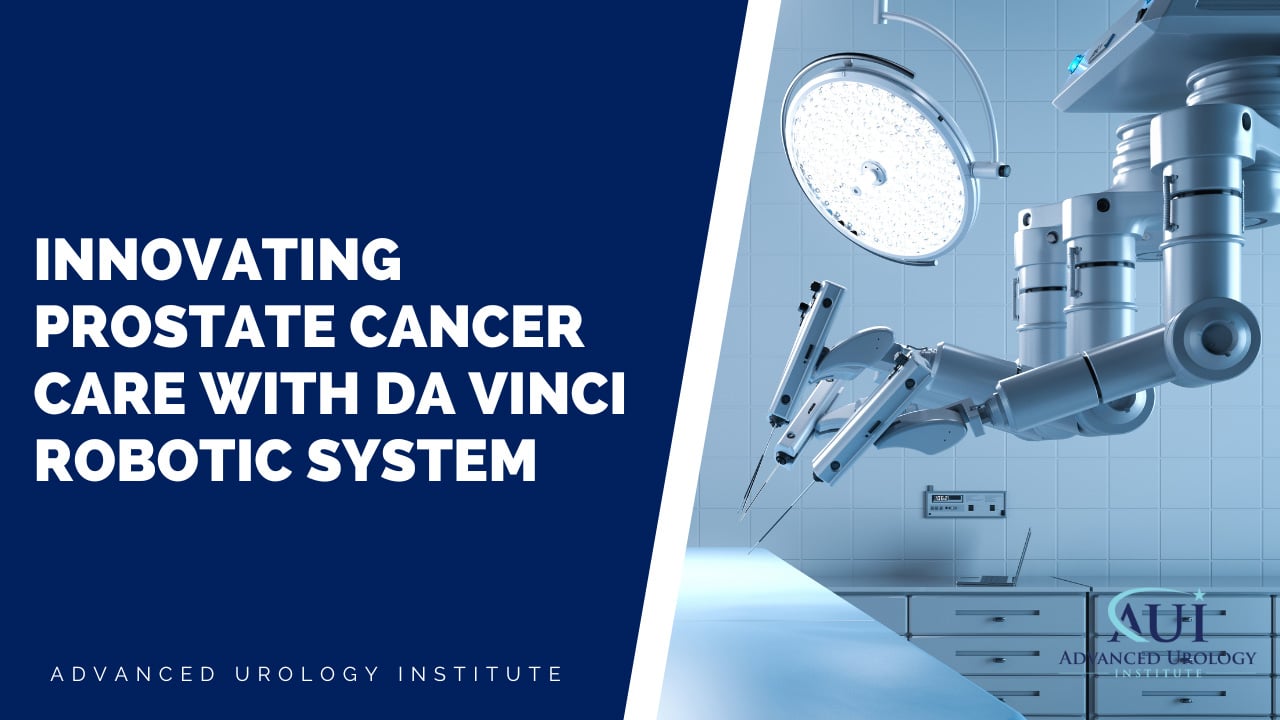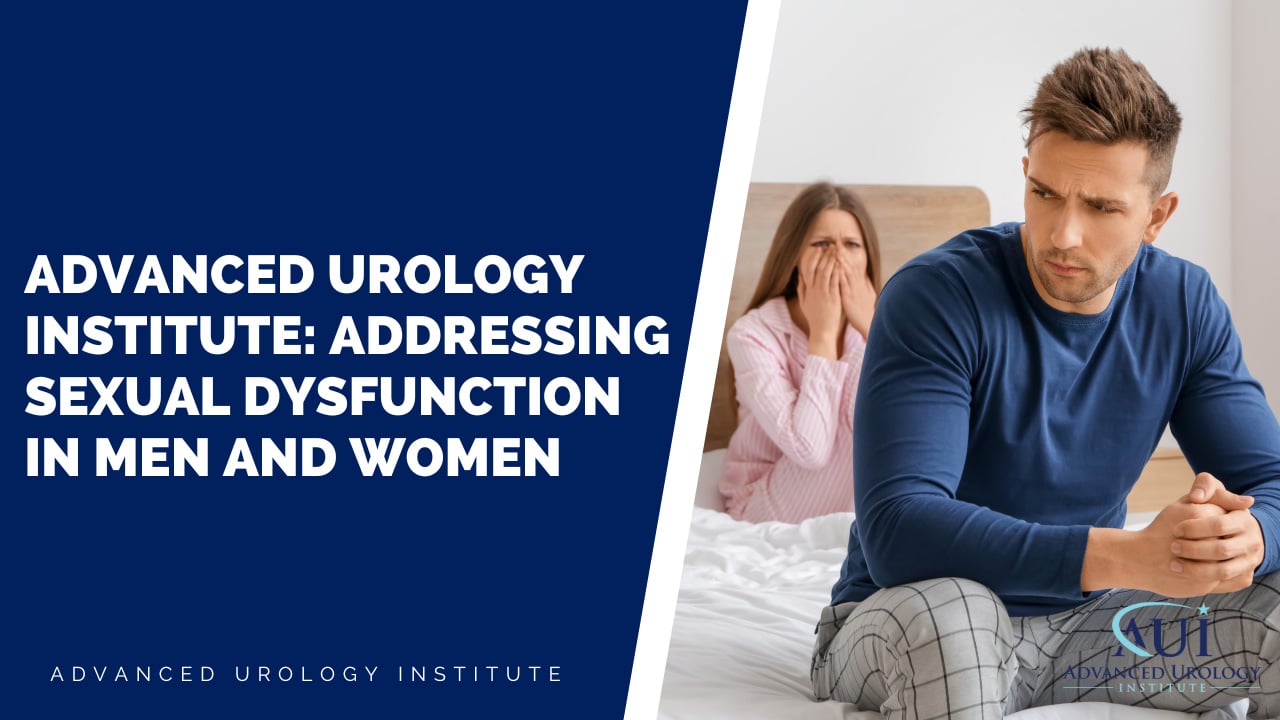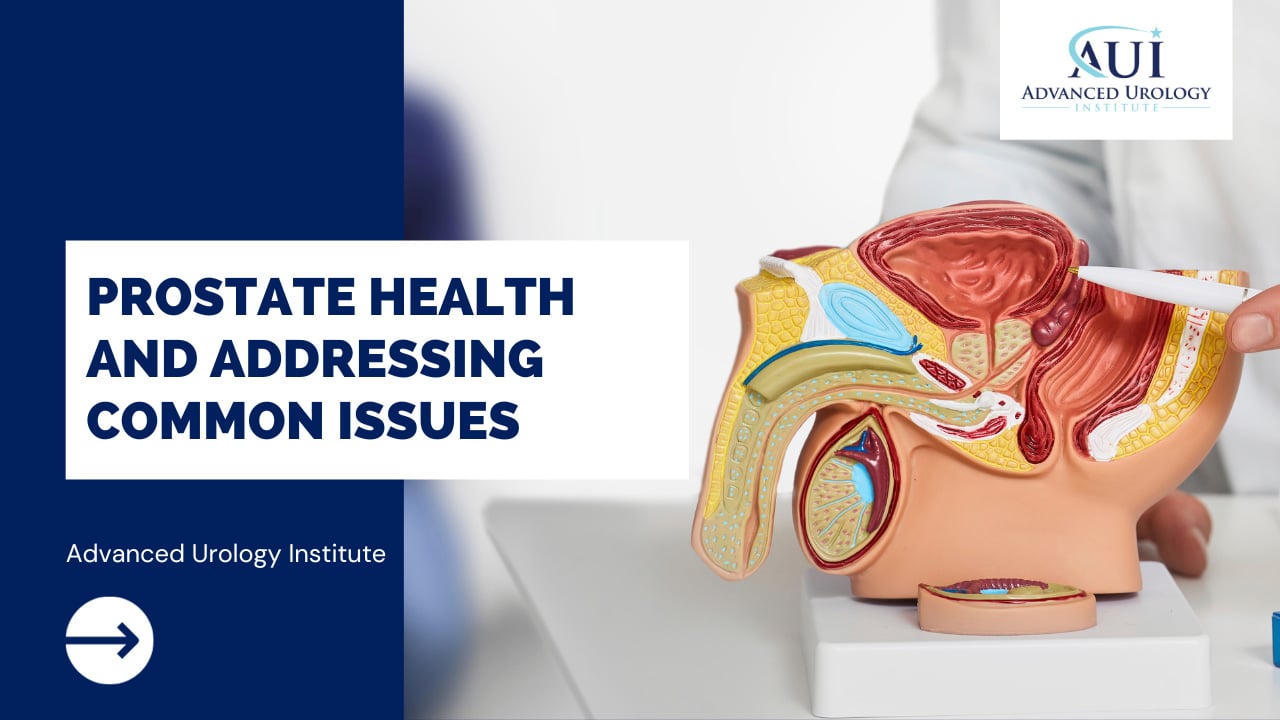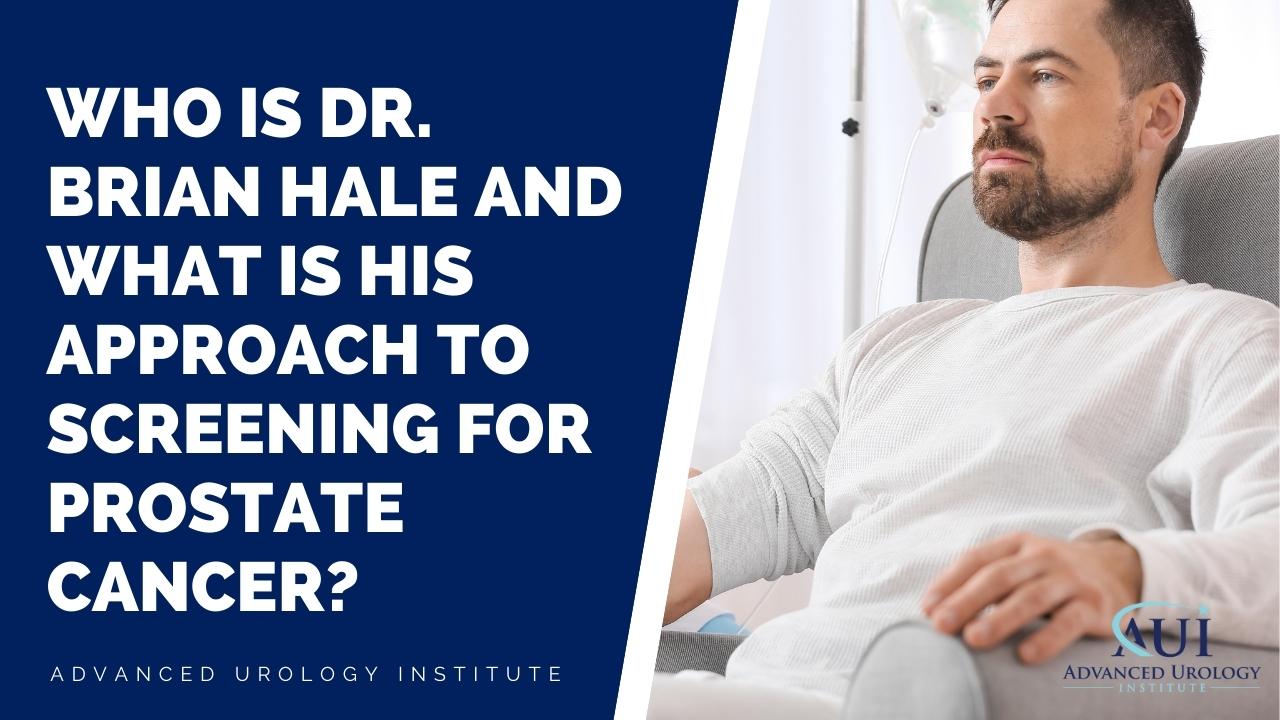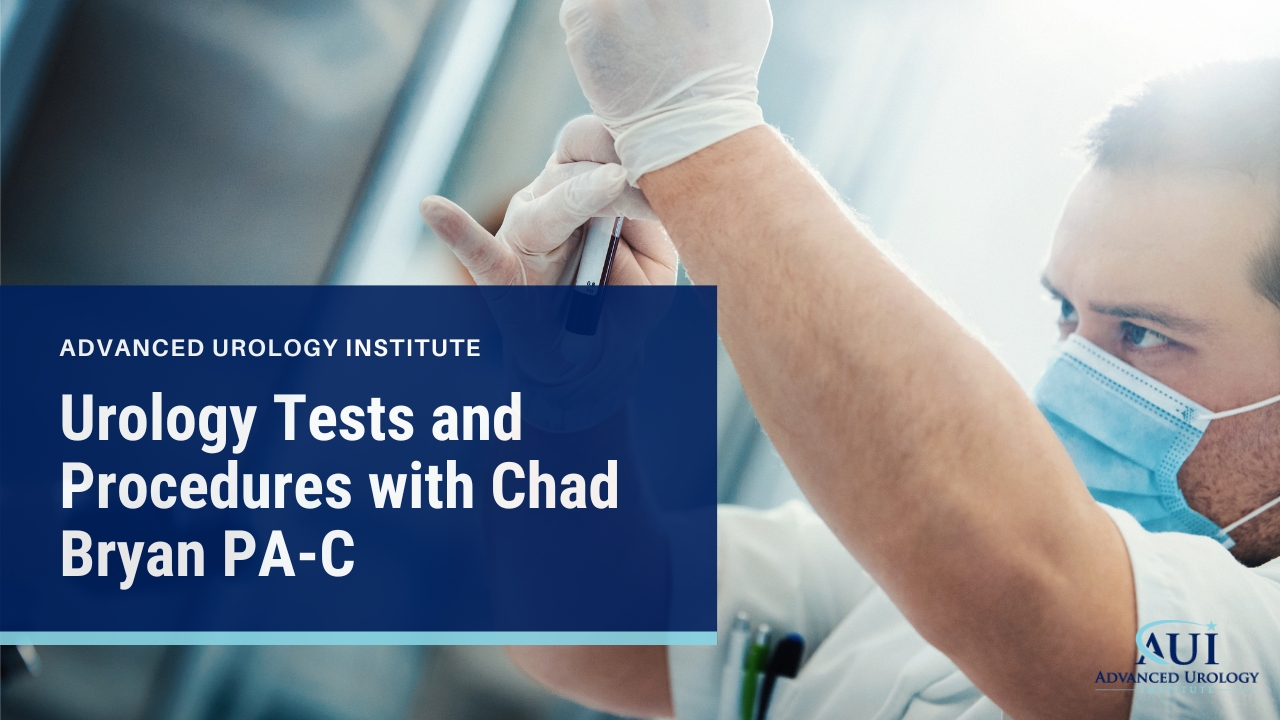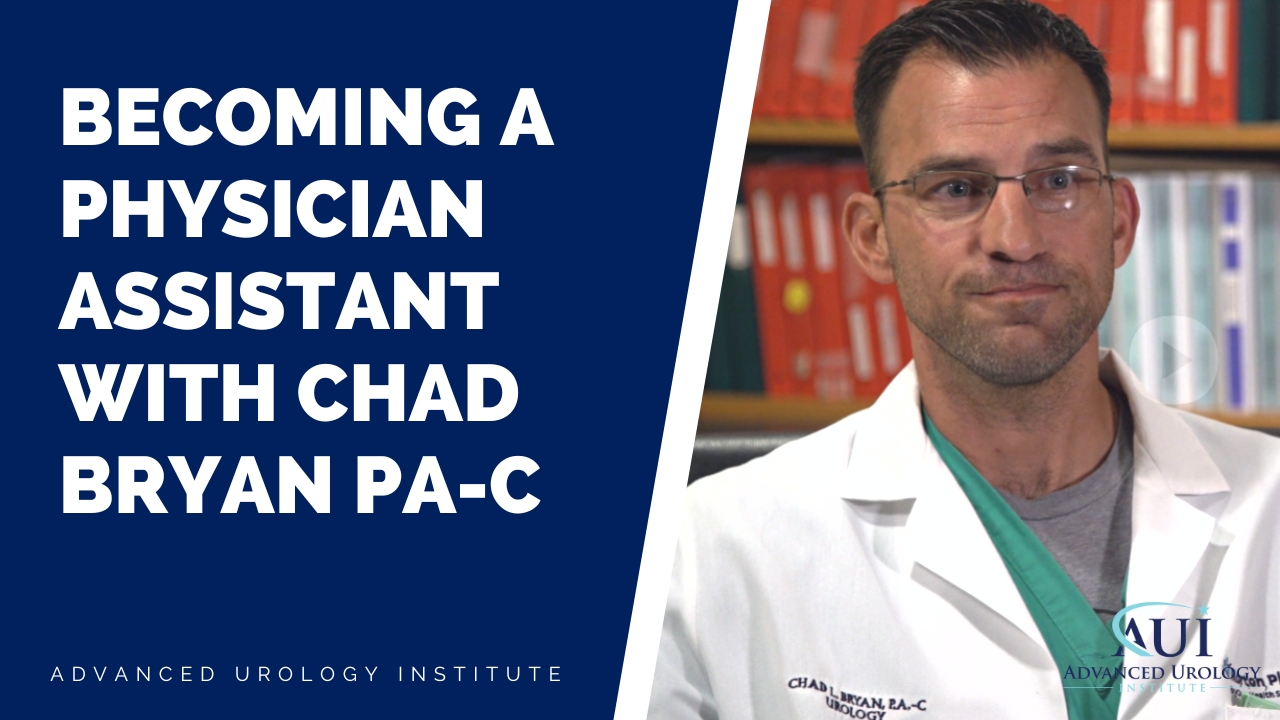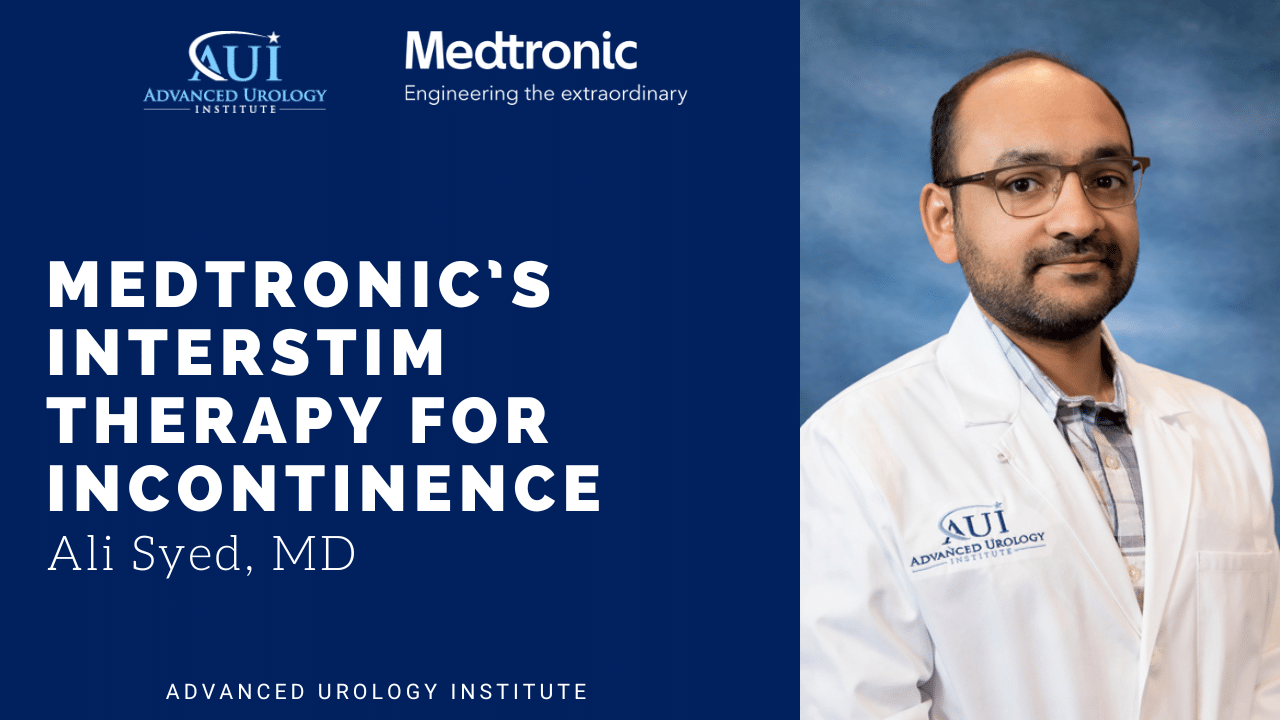Drs. Jay and Bassel, board-certified urologists in Naples and Palm Harbor, FL, respectively, talks about addressing common female urology problems.
Continue readingNavigating Prostate Health – When to Consider a PSA Test
Wondering when to consider a PSA test? Drs. Yaser Bassel and Howard Epstein recommends early screening for certain at-risk groups.
Continue readingExploring Treatment Options for Erectile Dysfunction
Explore treatment options for erectile dysfunction with the expertise of the urologists at Advanced Urology Institute in Florida.
Continue readingInnovating Prostate Cancer Care with Da Vinci Robotic System
Transforming prostate cancer care with the Da Vinci Robotic System. Our FL urologists utilize this advanced technology for precise, minimally invasive procedures
Continue readingAdvanced Urology Institute: Addressing Sexual Dysfunction in Men and Women
The subject of sexual health can be difficult especially when talking about the sexual dysfunction in men and women.
Continue readingProstate Health and Addressing Common Issues
Living with prostate health issues can be challenging. Understanding the way the prostate gland grows and functions is key.
Continue readingExcellent Urological Care at Advanced Urology Institute’s Palm Harbor US 19 Office
Advanced Urology Institute’s office in Palm Harbor, FL is designed to deliver nothing less than top-tier urological care. Learn more here.
Continue readingWhat are Dr. Yaser Bassel’s specialties in urology?
Dr. Bassel main interest is robotic surgery in urology, which allows for precision and minimally invasive treatment of cancer-related issues.
Continue readingWho is Dr. Brian Hale and what is his approach to screening for prostate cancer?
According to Dr. Hale, all men over the age of 50 should be screened for prostate cancer to avoid any serious complications in the future.
Continue readingPalm Harbor East Lake Office: Advanced Urological Care at Your Doorstep
At our Palm Harbor East Lake Office, you’ll find a team of highly skilled urologists and staff equipped with empathy and expertise.
Continue readingWhat is Urinary Incontinence in Women and how can Dr. Amar Raval help?
KEY TAKEAWAYS:
- Women commonly experience stress incontinence and urge incontinence, both of which can significantly impact their quality of life.
- Dr. Amar Raval offers various treatment options, including medications, Interstim devices, Botox, needle acupuncture, urethral slings, and robotic surgery.
- The Advanced Urology Institute, led by Dr. Raval, is committed to helping women improve their quality of life and confidence by addressing urinary incontinence.
Urinary incontinence can significantly impact a woman’s quality of life, causing embarrassment, discomfort, and inconvenience. Dr. Amar J. Raval, a urologist in Tampa, FL, offers various treatment options for women suffering from urinary incontinence. The Advanced Urology Institute, the largest urology practice in Florida, provides comprehensive care for women experiencing urinary incontinence and other urological issues.
Types of Urinary Incontinence in Women
Women often experience two main types of urinary incontinence: stress incontinence and urge incontinence. Stress incontinence occurs when women leak urine during activities that put pressure on the bladder, such as laughing, coughing, or sneezing. Urge incontinence involves a sudden, intense urge to urinate, followed by involuntary leakage of urine. Both conditions can be distressing and inconvenient, but treatment options are available to help manage the symptoms and improve women’s quality of life.
Treatment Options for Urinary Incontinence
Dr. Raval offers a variety of treatment options to help women manage urinary incontinence. These options include:
- Medications: Some medications can help control the symptoms of urinary incontinence, particularly urge incontinence.
- Interstim device: This device stimulates the sacral nerves, helping to regulate bladder control and reducing the symptoms of urinary incontinence.
- Botox: Injections of Botox into the bladder can help relax the bladder muscles, decreasing urinary urgency and leakage.
- Needle acupuncture: Acupuncture needles can help stimulate specific points on the body, which may help reduce the symptoms of urinary incontinence.
- Urethral slings: These surgical devices can support the urethra and help prevent stress incontinence.
- Robotic surgery: For women experiencing bladder prolapse, robotic surgery can lift the bladder and prevent further prolapse.
Improved Quality of Life and Confidence
By addressing urinary incontinence, women can experience improved confidence and quality of life. Dr. Raval and the team at the Advanced Urology Institute are dedicated to helping women regain control over their bladder and live more comfortably and confidently.
Advanced Urology Institute
The Advanced Urology Institute is the largest urology practice in Florida, providing comprehensive care for patients experiencing urinary incontinence and other urological issues. Led by experienced professionals like Dr. Amar Raval, the institute offers personalized treatment plans designed to address each patient’s unique needs and preferences.
TRANSCRIPTION:
Women generally present with issues like stress incontinence where they laugh, cough and sneeze
and leak urine or feel the urge to go don’t make it in time and leak urine and those are
big issues for them to have to wet themselves while they’re out in public and to be able
to control that with either it’s a medication or different other devices whether it’s an
interstim device, Botox or you know even a needle acupuncture needle that can have sense
to help mitigate that. I think there’s a lot of options that are available as well as for
stress incontinence, urethral slings or if they have prolapse or bladder prolapse or there’s also
robotic surgery that you can do to kind of lift the bladder up and to prevent the prolapse. So
I think from a lifestyle standpoint it makes a big difference and women are generally happier
and more confident in themselves.
REFERENCES:
- “Types of urinary incontinence – Harvard Health.” 28 Dec. 2014, https://www.health.harvard.edu/bladder-and-bowel/types-of-urinary-incontinence.
- “Urinary incontinence – Diagnosis and treatment – Mayo Clinic.” https://www.mayoclinic.org/diseases-conditions/urinary-incontinence/diagnosis-treatment/drc-20352814.
- “Urinary incontinence treatments for women (Beyond the Basics).” 16 Mar. 2022, https://www.uptodate.com/contents/urinary-incontinence-treatments-for-women-beyond-the-basics.
Urology Tests and Procedures with Chad Bryan PA-C
Chad Bryan, a physician assistant for Advanced Urology Institute, discusses the importance of understanding prostate health in men. He highlights how society is becoming more educated about the issue through direct advertising from pharmaceutical companies.
Continue readingBecoming a Physician Assistant with Chad Bryan PA-C
Becoming a PA requires a significant amount of education and experience, but for those who are dedicated to the profession, it can be a rewarding and fulfilling career choice.
Continue readingTreatment Options That Are Available for Prostate Cancer – Dr. Amar Raval
In this video, Dr. Raval provides a clear and concise overview of the different treatment options for prostate cancer. It is important for patients to take an active role in their own care and work closely with their doctor to develop a treatment plan that is tailored to their individual needs and circumstances.
Continue readingMedtronic’s InterStim Therapy for Incontinence with Dr. Ali Syed
You have probably heard the term incontinence, but do you really know what it is? Incontinence is loss of control of a person’s bowels or bladder that results in accidental leakage of body fluids and waste. Therefore, it’s a physical problem but also one that can diminish quality of life. Someone dealing with incontinence may avoid sex, physical activities, social outings, and hobbies out of fear they may leak urine or stool.
Fortunately, AUI can help with this life-altering problem. Medtronic’s InterStim Therapy, which could be called a “pacemaker for the bladder,” works great for those who have frequent urges to urinate. With surgical implantation of the InterStim device, a thin wire with a small electrode is placed near the sacral nerve. The device produces electrical impulses, which are sent to the sacral nerves and reduce hyperactivity of the bladder.
Dr. Ali Syed of AUI has helped countless patients enjoy a drastic improvement in quality of life thanks to InterStim therapy.
If you’d like to learn more about what this treatment entails, we strongly encourage you to watch the video. You can also attend one of Dr. Syed’s seminars on InterStim therapy.
It just might be your ticket to relief and a normal life.
Riggio, Kristi
00:00My name is Christy Rio, and I’m. With Medtronic.
- 00:02Some of you may
- 00:04no medtronic as the company that invented the pacemaker back in the one thousand nine hundred and fiftys
- 00:10tonight, Dr. Ali Sayed, with advanced Yourology Institute, will be discussing treatments that may help patients who have symptoms of overactive bladder, urinary incontinence, retention of urine, and valid continents.
Ali Syed, MD
00:24One of these treatments was developed might have been medtronic about twenty five years ago, and it’s called inner stem
Riggio, Kristi
00:32it was, It was approved on the market in one thousand nine hundred and ninety, seven, and since then patients around the world have been receiving relief from this therapy.
- 00:41We will have a poll this evening, so please take a moment to answer the Pope questions that appear on your screen as a reminder. Everyone’s phones were muted upon entry of this Webinar, and you are muted. If you do have a question, please feel free to type it in the Q. And a box at the lower portion of your screen,
- 00:59and the doctor will answer these questions. After the presentation.
- 01:02Again, this presentation is being recorded.
- 01:06There will be a short survey at the end of the presentations that you can share your thoughts.
- 01:13I would like to at this time introduce Dr. Sayed. Dr. Sayed.
Ali Syed, MD
01:19Thank you, Christie, for the kind introduction, and I welcome everyone who has joined us this evening. So we’re going to talk about some bladder and bowel issues today. Let’s see if we can get these slides go forward.
- 01:34All right. So surprisingly, fifty percent of patients have had incontinence, and they just have not discussed this with their doctor, whether it be their primary care, doctor, or their urologist. I often see patients in the office, and they ask questions such as will I ever regain control.
- 01:53How can I possibly go on a date? Can I attend an outdoor celebration? I’m afraid to leave my home, you know, and the bathroom is basically always on my mind, and I map out my roots so that I know where the next bathroom is.
- 02:06So the agenda today is to understand bladder and ballot control, to kind of figure out the care pathway, to discuss some treatment options, to discuss the meatronic inner stem system, to discuss the metronic neural system. And then we’ll answer some questions.
- 02:22So
- 02:23the thing that Ah amazes me and amazes a lot of patients when i’m on these statistics is that overactive bladder and fecal incontinence are extremely common. Ah, one in six adults have oav or o’reactive bladder, and that accounts to thirty seven million Americans, and Similarly, one in twelve Americans have equal incontinence, and that accounts for about twenty million Americans. So compare this to something that’s common. It’s a vision problem that’s about twelve million adults or people with asthma in the Us.
- 02:52That’s seventeen million. So way more people have overactive bladder and fecal incontents. But the biggest issue is that people don’t like talking about it because they’re embarrassed.
- 03:03So the question is, what is normal. I often hear that I felt that i’m having a symptoms just because i’m getting older. But the reality is that urinary and balanced continents are not a normal part of aging. So people come to me with frequent accidents. I have to go now. They plan their activities around a pay bathroom. They monitor what they eat or drink, and often restrict what they drink. At the time of events, and often are using pads and protection
Unknown Speaker
03:33of garments.
Ali Syed, MD
03:36So it’s kind of important to know what the normal physiology is. So the question is, how does bladder control work so normally? Your kidneys? Ah, make urine, and the urine is stored in the bladder. When the bladder is about half full. It stimulates your nerves by telling your brain, hey? If I have to go to the bathroom, and then the job of the brain is to coordinate your blood, or when it’s socially acceptable for you to go eat. And what happens in whole rack of bladder is
- 04:01the control between the nervous system and the bladder breaks down, and therefore the social cue is gone away, so you cannot control. Hey? I don’t have a bathroom nearby. I want to hold on. That does not exist any.
- 04:14Similarly, bowel control works in a very similar fashion. So when you eat the digestive system pushes the food through your intestine. Ultimately it reaches the rectum, and when the rectum is full it stimulates your nerves, or or sends a signal to your brain,
- 04:28saying, Hey, is it socially acceptable for me to go have a development, and if it’s not, your brain tells you, ruptum to know. Find a bathroom. Wait, and when you do it it relaxes. You speak for muscle.
- 04:42And similarly, when there’s a communication breakdown between the brain and the rectum, it causes issues with controlling your bowel movements.
- 04:51So what causes incontinence on various different things. So there’s daily habits in regards to what you’re eating and drinking.
- 04:57Ah! Sometimes medications can cause incontinence. Sometimes reduced. Physical mobility can be associated with incontinence, and finally, common things, such as pregnancy, childbirth, radiation, public for injury, Previous surgeries of the public prostate surgery and men all of these things can be associated with
- 05:17um ordinary incontinence.
- 05:21So there’s three common bladder control problems that we often see. One is stress urinary continents, and we’ll. We’ll define this a little bit more. But the key here is that stress urinary content is not treated by the metronic system. There’s urinary retention, and then there’s all proactive bladder, which also has spurging on it. That’s where you have to go, and you have accidents in trying to make to the back.
- 05:43So as they mentioned. So what is stress you’re in on this. So this is the leeches that we experience when you sneeze when you cough and you laugh, or if you get up to quite well, if you’re exercising um, you’re going up the stairs. Then you experience a little ticket. So this is the accident that happens with activity, really. And this, again, is not treated by the electronic system. There are other treatment modalities for this that exist that we’re not talking about today. But this is a treatable condition.
- 06:11Next, what is your area of attention? So this is a feeling where you can’t tell your bladder’s full, or you know it’s full, but you’re unable to empty it. And sometimes the symptoms that are associated with it is weak dribbling, screening. Sometimes you have to use a Cath, that I’ve seen patients that come to me with a cat in place. And so that is your in your retention, and we work that up to see if it can be fixed by a stimulator.
- 06:37And finally, what is overactive water so overactive bladder has two components: urge incontinence and emergency frequency. So what urgentontinence means is that you start going before you reach the bathroom, meaning you have accidents before you can make it to the bathroom, and often you’re wearing pads and effective garments out of embarrassment. You’re in a frequency something similar. Basically it’s you have to go to the bathroom quite frequently throughout the day. And that’s more than that’s defined as more than eight times.
- 07:07The only good thing here is that you’re not having accidents, so you have to go real bad. You are able to make the bathroom, or you’re going back. And again, patients tell me things like, hey? I never drink a meeting, or when I go out for dinner. I don’t drink much, because i’m worried about having an accident.
- 07:24Finally, what is fecal incontinence? This is a entity that again is quite common, but unfortunately, people are embarrassed to talk about it. But basically this is a origin continents which is an inability to resist the urge to go, and you have an accident with your stool, and similarly passive incontinence is the inability to feel the need to go to the bathroom.
- 07:49So the good news is, There are various treatment options, and all of them have a good success rate. We’ll discuss some of them. So basically the pathway in diagnosing this is when you come to the office to run some tests. We make a diagnosis to see what type of income and survival issues we have.
- 08:06Then we usually recommend dietary and lifestyle changes. If that doesn’t work we out of medication, and if that doesn’t work, then we really discuss some advanced therapies.
- 08:17So again, there’s some simple solutions, Lifestyle and dietary changes often helps
- 08:21many people, and that includes limiting fluids that are bladder, irritants, exercising and and pelvic fluor. Physical therapy often helps
- 08:31that doesn’t work, we add some oral medications. Um. The benefit of medication is, It’s a you have to take. However, there are some downsides, and it basically is a lifelong medication that you have to take, and unfortunately, some of the good medication that we have have side effects on the market that include dry mouth, which inevitably makes you drink more water, and therefore you’re going more often to the bathroom. Ah, blurry vision or dry eyes, constipation which can worsen urinary symptoms and also high blood pressure.
- 09:00In fact, there was a recent survey that seventy two percent of people stop taking their blood or medication due to these side effects. So it’s not a really a good long-term option.
- 09:11Then there are advanced therapies that we kind of talk about once the medical treatment Haven’t worked and for bladder control. This really is a metronic inner stem system which we’ll talk about. The metronic nervous system and injected medication, such as poc
- 09:26for bowel-control adoption is slightly more limited, but also very good, and that includes the electronic intersection system and some surgical options with regards to the Enol speaker.
- 09:38So again, there’s risks and benefits of each, and we’ll review a little bit of it. So Botox um is a medication that’s used to treat overactive bladder that’s injected into the bladder muscle through a needle. Um, and it’s a it’s It’s quite comparable to oral medication. The downside is that it does each of you repeated every ah few months as it loses efficacy. Um! For a period of four months or so it also does not treat eco in the continents, and there is a small percentage of people that have to
- 10:08rely on cathedralizing because the Botox worked too well. So with that said, You know, fifty one percent of the patient do stop the treatment after concessions, mostly because people don’t want to keep on going through the injection treatment every few months.
- 10:23The ptnmetronic neurosystem is also a very safe, effective, minimal, invasive. Ah, therapy! It’s shown to reduce urgency, frequency and urine content, and sixty seventy percent of patients Um, It restores bladder function by gently stimulating the trivial nerves. But it does not treat people in common. Um! And it’s very safely to del delivered in the office environment. It’s a thirty minute session. It takes a you know, one session for a week, and if you’re released from that then we kind of start
- 10:53the maintenance sessions for long-term relief. So the benefit is it’s quick, easy, minimal, invasive. The downside is you need to have persistent treatment to maintain your symptomatology?
- 11:05And Finally, the sacred neuromodulation mechanics system is a system that basically corrects what the pathology is. So, as I mentioned, the issue again, is a breakdown in the communication between the brain, the bladder and the valve. And what this stimulator does is that it restores that function. The benefit is that there’s actually a test that we do in the office that i’ll talk about shortly to see if it’s a very good candidate for.
- 11:35And before I move on, actually, this this system has been on the market for well over twenty years, and it’s Fda for all of the indication that we’re talking about with pretty high success Raiders and studies that show over eighty, five to ninety percent success rate in reducing the symptoms over fifty percent. So the evaluation is quite simple. The test is done in the office or an outpatient center, and we basically place a thin wire
- 12:03in the upper part of the butt off. It takes about twenty to thirty minutes. You’re awake for this part, and then the leads attach to an external device, as shown on the patient. Here, with a little belt,
- 12:16and over a period of three to seven days or so. We adjust various programs to see if you’re symptoms, and if your symptoms improved over fifty percent from where we were when we started. Then we say, Hey, this is a good treatment option for you, And then we kind of decide on the permanent implant.
- 12:36So again, the technology it has been around for several years. It’s safe and effective. It has good data, showing how well it works. In fact, eighty nine percent of people who, using the electronic of valid controlled therapy experience, long-term success.
- 12:51And similarly, seventy six percent of patients experience success with their bladder control. Which is way more compared to medications, which is under forty nine percent.
- 13:02So is this the right therapy for everyone? Um. The answer. The short answer is, No, we do an evaluation in the office. See what type of incontinence you have. Ah, what type of ecal incontinence you have! Ah, evaluate your blotter and make sure everything else is healthy, and then we decide if it’s the right therapy. And again, if it is there’s a quick and easy test that can be done in the office for an operating center to see if it will work for you before we put the full thing
- 13:32all right, and that’s the conclusion. So i’m happy to take any questions at this point, and I hope this was informative for everyone that joined us this evening.
- 13:45Okay, thank you, Dr. Sayed. For that presentation. I do have a lot of questions actually, that have come in during the talk, so I will get started.
Riggio, Kristi
13:58One of the first questions is, Can I get an Mri with the inner stem system.
Ali Syed, MD
14:03That that’s an excellent question. And the short answer is, yes, Historically, the answer was no. But recently we’ve been able to develop technology where the Mri is completely safe with the system.
Riggio, Kristi
14:17Okay, Okay, Thank you. Um. If you do want to ask a question, just feel free to click the Q. And a button on your screen, and there you can type in your questions. Um, here I have a couple more that have come in um. Do you see most of your patients, do you see? Do most of your patients see good results
- 14:36from the test? And I guess this is also tests, says tests,
- 14:42implants.
Ali Syed, MD
14:44Yeah, that’s a great question. Um, I would say about, you know. Do you appropriately select the patient um about eighty to ninety percent of my patients about excess success. Um with the test. If the test in the office doesn’t work, there is an advanced test that we do in the surgery center um where the permanently displaced and often uh five to ten percent of those patients will respond as well. Um. So overall. I think that rate in my practice it’s the eighty-five to ninety percent which is comparable to the long
Unknown Speaker
15:14can be it like this:
Riggio, Kristi
15:16Okay.
Ali Syed, MD
15:17And The one thing i’d like to add is, I think, the biggest thing that’s underutilized is for fecal incontinence. It’s amazing how how those patients have significant restoration of their quality of life after this device, and often i’ll here, you know i’ll do it for urinary complaints, because that’s what the picture comes to me for, and often after the fact, i’ll hear, Hey, my my mouths are way better,
- 15:39because people just don’t like talking about the fecal incontinence part. But that’s where it’s a really unique therapy.
Riggio, Kristi
15:48Well, that was great, because that was one of the questions that came in. Dr. Sad was Um, if it worked for bowel control, so we’ll move on to the next one. Then we already answered the question with the Mri. So that was the answer asked again.
- 16:06Then that again asking about ball and continents that was asked. That’s another one.
- 16:14Here was one. Um! What is the recovery after the test? And then also, what is the recovery after the implants?
Ali Syed, MD
16:24So. Ah,
- 16:25yeah, that’s that’s a great question. So after the test, the recovery isn’t so much So in the sense that you don’t really have any restrictions except no flu, goals and
- 16:36and fast until the weeds are in. So that’s again about three to five days. There are no incisions or cuts on you. The the the Tesla’s are deployed all through a little needle, so there’s not much recovery. Um, in that sense, except for three days you have the weeds, and then, after the implant, the recovery is about two weeks, so for pain can. The biggest incision you have is about three to four centimeters in the buttock, and the biggest restriction again I have is
- 17:04avoiding swimming pools that as oceans is to prevent infection um pain. Most people are pretty minimal. I just have Tylenol and emotion um for pain control, and the results are pretty pretty immediate, and that you see with it once the system is installed,
- 17:20and also The other thing to to note is that nowadays with metronic, the system lasts up to ten to fifteen years. So you don’t really need to change anything or change the battery unless there’s an accident or a fall which breaks the lead, and then you need to change it out.
Riggio, Kristi
17:37Okay, perfect. That was That was one of the next questions was, How long does it last? So you answered that
- 17:43question, and then the other one is I I guess you did it. Can you see the device under the skin?
Ali Syed, MD
17:51Um, no, you can feel it, but you definitely cannot uh see it. So we put it in the uh in the buttock, so you can see the incision on the outside. But you can’t see the device.
Riggio, Kristi
18:02Okay? Next question is, can you?
- 18:06I guess the question is, can you manipulate the device? Um, once you have the have the implants, so can I? I guess you’re asking if you can make changes or change.
Ali Syed, MD
18:16Yeah. So you know, It’s controlled through like a little telephone like a smartphone, and there are various programs that can be changed. Um, in terms of physically moving the device. It shouldn’t move unless there’s again a fall or a trauma of some sort. But you can adjust the programs, and you know, check it and make sure it’s working well and stuff like that.
Riggio, Kristi
18:36It’s.
Ali Syed, MD
18:37Um. Is there an age range for? Is there an age where a a patient can no longer get this device. Um! Was one of the questions
- 18:47right great question. So from the Fda there’s no age limit on who can get the device, and who can, from my perspective as a physician. Obviously,
- 18:57I would want to not put anyone who has multiple medical issues under anesthesia and stuff like that. So you know we make sure you’re healthy enough to undergo the procedure before we do it. But there’s no age restriction that I’ve had good results with people in their late eighty S. For example. And similarly, I’ve had excellent results with someone in their thirty S. So there’s really no age restriction. In fact, in my training. We did it in the pediatric world with with good success.
Riggio, Kristi
19:23Okay, where is this? Where Where is the test and implants performed?
Ali Syed, MD
19:32So it’s usually performed either the implants performed at a survey center, and the test is usually also performed in an outpatient center, and rarely in the
Riggio, Kristi
19:43and I think That looks like all the questions. There was a couple of duplicates here. Oh, there was one here. What about a Tsa security check?
Ali Syed, MD
19:53That’s a That’s a great question. So electronic gives a little implant hard to shape it to show that you have a little bit of a given an implant in there, and I haven’t heard any issues. Kristy, Have you heard of any issues with this?
- 20:05No, that that was something. That was the case many, many years ago, but no no no longer Patients um bring their car. They say they have a medically implanted device. Usually the the Ts agent will ask, Where is that? By the planet, and they’ll just use the wand they Won’t have you go into the X-ray machine
- 20:24it doesn’t have anything it won’t damage the um implants whatsoever. If you were to go into the um the X-ray machine, but they just they just wand you instead. Um, I guess that’s their protocol for safety from the Tsa. There’s no
Riggio, Kristi
20:42no interaction,
- 20:46so I guess that was all of the questions. Thank you all for your time and participation tonight in the Webinar Um. You can see back our seeds information on the screen. He’s both in Palm Harbor and in Trinity, and you’ll see his phone number there, and you can give the office a call to make an appointment to see him see if he would be a candidate
- 21:07for inner stem.
Ali Syed, MD
21:10Awesome? Yeah, no, uh Kristy, Thank you for hosting this, and again I appreciate all everyone joining this evening and spending some time with us to learn about incontinence.
- 21:21Thank you. Thank you all. Good night.
Make an Appointment with Dr. Ali Syed Today
Palm Harbor Office
35095 US Hwy 19N, Suite 202
Palm Harbor, FL 34684
(727) 771-0600
Trinity Office
2148 Duck Slough Blvd., Suite 102-103
New Port Richey, FL 34655
(727) 375-1975




